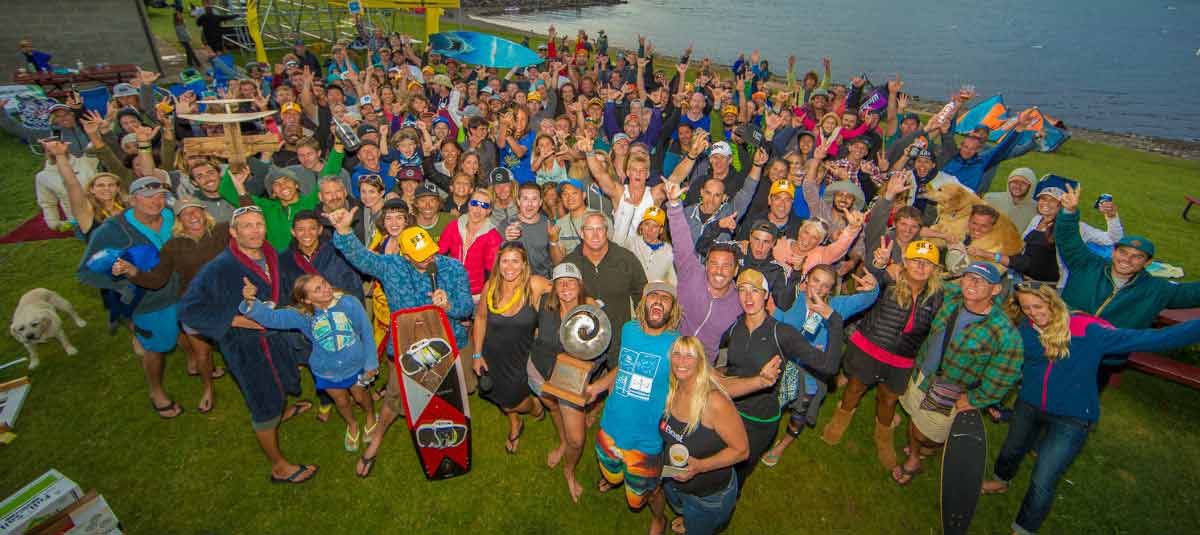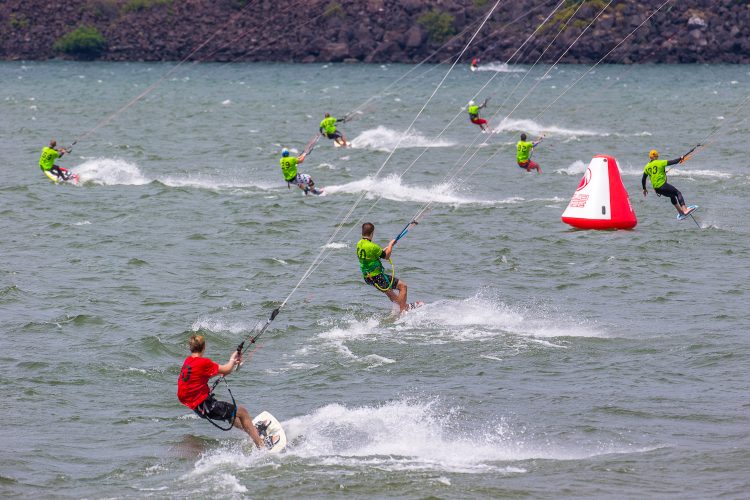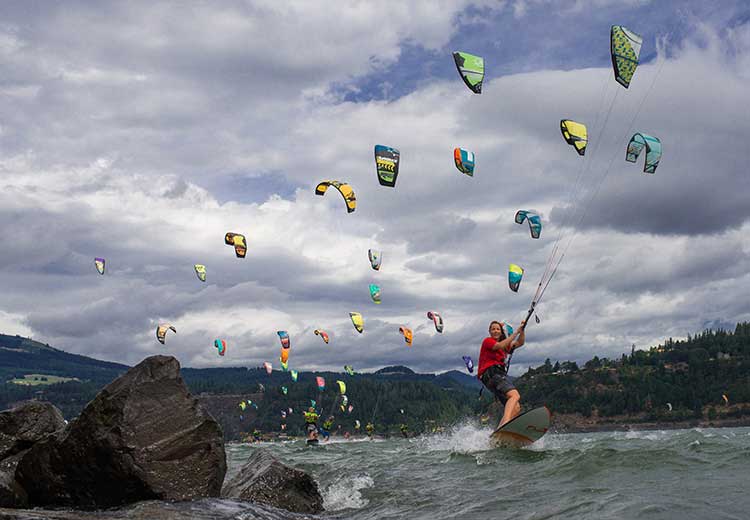How to Plan a Fundraising Event That Raises $120K

The annual fundraising event is a huge revenue-driver for many nonprofits, but they often struggle to scale results year over year. Then there are organizations like Athletes 4 Cancer (A4C), who execute a ninth annual event that raises a whopping $123,422—a record fundraising yield.
Fundraisers alone raised $76,506 on the Classy platform, with the average fundraising page bringing in $941.
The flagship two-day event, Kiteboarding 4 Cancer (KB4C), rallies participants to kiteboard race and support A4C’s camp survivorship programs. To maximize fundraising results, A4C motivated supporters to fundraise for entry into the event.
With the help of CauseMic—a digital cause marketing and fundraising consulting firm—A4C’s main focus is to help fundraisers reach personal success and plan a fundraising event that gets attendees excited. None of this could be possible without the extensive preparation and strategy beforehand.
Here, Tonia Farman, A4C’s co-founder and executive director, and Noelle Smith, an account strategist from CauseMic, share insights on how to plan a successful fundraising event.
Write a Mission Statement
When planning any fundraising event, Farman always begins with a written mission statement. It directs all of her decision-making processes. She says,
“Whether I’m ranking priorities, choosing a potential partner, or making any kind of choice, I follow my mission as my guiding point.
KB4C’s mission is “to harness the power of wind and water with the passion of the human spirit to benefit lives affected by cancer.” While simple, it pilots all decisions to make the event what it is: including the sponsors Farman recruits.
Find Sponsors Who Align With Your Mission
When considering how to plan any fundraising event, Farman focuses extensively on landing corporate giving opportunities that support KB4C’s mission, and she respectfully declines those who fail to do so. When she does find a compatible partner, her value proposition always revolves around their similar visions. She says,
“I’ll basically approach them and say, ‘Hey, it looks like you guys really have synonymous values with our organization and what we try to do with this event. Here’s our mission. We think you’d be a great partner, and here’s why.’ That way, you’re showing the company that you did your homework, and you can show them that you both want the same thing.”

“Sponsors know what they want, so just ask them, ‘what is most valuable to you?’ Then you can tailor your response and assets.
Beyond creating social impact, Farman still needed to figure out how to further incentivize corporations to back the event. What other benefits did they want in return for their sponsorship?
She found an effective solution: just ask them.
“Some brands will say, [they] don’t care about getting their logos promoted; we just want a team at the event, our people to participate, and the announcer to promote our product,” she says. “Then, there are other partners who don’t care as much about participation day-of. They want to be more associated with the event on the branding side. Sponsors know what they want, so just ask them, ‘what is most valuable to you?’ Then you can tailor your response and assets.”
Farman now has two different packages to send to potential sponsors: one for those who want more opportunities to participate at the event, and another for the ones who prioritize pre-event promotion. Not only do these personalized benefits improve sponsor retention, but they also equip her to up the ante a bit the next year.
“For instance, one of our sponsors is KIND Snacks. I know their main priority is getting a KIND bar in everybody’s hands at the event. The next year, I might say, ‘Hey guys, if you can do a $1,000 sponsorship instead of $500, then not only can we put bars in every athlete’s bag, but we can have different areas have little KIND displays that you can bring and manage.”
Therein lies another tip to recruiting sponsorships: when possible, offer more benefits without increasing your own workload. Put it on the sponsor to bring their game.
I try to balance not doing too much work myself. I try and empower the sponsor to do the work. I just give them the opportunity, and I’m really clear about what that is.
And of course, that all comes back to the sponsor’s mission aligning with your own. When you’re confident about their values, and how their support will represent your organization, you’re in a better place to build a partnership that is authentic and means that much more for the sponsors involved too.
Plan Email Touch Points With Fundraisers

With the help of CauseMic, Athletes 4 Cancer motivated 77 fundraisers to raise money for KB4C 2015. Their main communication channel was email. To target them with tailored content and helpful assets, CauseMic created two email tracks. All fundraisers received both email series, each at a different timeframe.
First Email Track
In advance of fundraising, CauseMic prepared an email series that contained three to four personalized messages to motivate supporters’ fundraising efforts.
Email #1: Fundraising Tips
This first email is sent out as soon as someone creates a personal fundraising page through Classy, and it includes three to five tips to help them get started.
“It might be a quick note reminding the fundraiser that they shouldn’t be self-conscious about reaching out to friends and family,” says Noelle Smith, Account Strategist atCauseMic. “It also usually includes tips to create a video, customize their page to tell their own story, and other similar tips.”
Email #2 and #3: Sample Messages
The following two emails check in with fundraisers and provide sample emails and social posts they can use to promote their campaign.
Email #4 (if applicable): Congratulations
“We also corresponded with people on a more personal level, like an additional message that congratulated them for meeting their goal,” says Smith. “If it’s the week before the event, we might ask them to consider raising their goal. But if they raised a high amount already, we wouldn’t ask them to raise their goals again.”
Second Email Track
About four weeks leading up to the event, CauseMic got fundraisers started on another bulk email series. These messages included less-personalized check-ins and more general announcements, such as matching challenges, updates, and reminders about last-minute fundraising.
“All fundraisers are put on this track. These updates are usually graphics-heavy, and the key is to keep them short and sweet. Since they’re receiving the first email series too, we don’t want to overload them with information.
The final email was a thank you specifically tailored for fundraisers. After the event, the team sorted out all of the individual photos taken of kiteboarders during the day. They used bib and jersey numbers to put names to faces, and they emailed these photos to individual folks as part of their thank you.
Those who didn’t have individual snapshots received a group photo of everyone on land. If A4C had a photo of one member from a fundraising team, they sent that photo to the entire team as a personalized shout-out for their efforts.

It turns out that when you use personal photos to tailor your thank you, fundraisers really appreciate that extra touch. It makes them feel recognized and important.
“The response was great,” says Smith. “People LOVE having photos of themselves, and we also got a lot of social shares of the high-quality images and individual photos we sent out.”
Pick Up the Phone to Lend Fundraisers a Hand
In addition to crafting tailored email tracks, CauseMic delivered phone calls to motivate fundraisers and ask if there was anything they could do to help. This personal touch was meant to relay authenticity and provide a heartfelt sense of appreciation. With about 77 fundraisers, the task was manageable.
“We called those who had raised money about two weeks ahead of the event. That’s when most of them have already raised some amount,” says Smith. “People were very positive. I left messages too. Some people don’t call back, which is totally fine because the point is to just let them know you see and appreciate all the effort they’re putting into the campaign. So at the end of the day, it’s really just a thank you.”
And while some organizations may think they’re creating more work for themselves by offering to help, most of what the fundraisers need you can have prepared ahead of time. For example, if the fundraiser asks for help writing an email to send to friends and family, you can send them a sample draft that you keep on file.
“The point is to just let them know you see and appreciate all the effort they’re putting into the campaign.
It’s not always feasible to call every single fundraiser—it all depends on the size of your organization and number of fundraisers you have. But the main takeaway is applicable to all organizations. When you want to motivate fundraisers to achieve success, you need to think about how you can show your genuine appreciation and support.
Read Next: The Ultimate Thank You for Nonprofits
On the day of the event, A4C updated their social channels—namely Facebook, Instagram, and Twitter—with fresh content, with the help of CauseMic. Because the organization’s community is predominantly active on Facebook, that’s where they focused most of their efforts.
Given that KB4C is the organization’s flagship event, the organization has two Facebook pages: one for Athletes 4 Cancer, and another for KB4C. While one might assume they can simply repost the same content across both pages, CauseMic understood that each page had a different audience.
“Many people who follow the A4C page are cancer survivors—meaning they’re not necessarily kiteboarders or hardcore board sport enthusiasts,” says Smith. “They’re connected to the event because the funds raised benefit their camp. So our messaging on that page is all about what this event is doing and what it means for them and the organization as a whole. The KB4C page, on the other hand, is much more detailed about what’s happening at the actual event, like how many laps the winners completed. We naturally had more frequent updates on that page.”
Tailor your content for each audience in order to maximize engagement. Depending on which of your supporters are on which channel, your hour-by-hour updates might be best for one while impact-specific posts are appropriate for another. This keeps your entire community engaged and connected to the event in the way that is most relevant for them.
Read Next: Social Media Demographics by the Numbers
Hire Two Event Coordinators
With so many moving parts, a fundraising event requires all hands on deck and a strategy to get things done. For A4C, that strategy includes bringing on the right people to help manage and direct every facet of the event. In particular, there are two main people she recruits to help everything run smoothly.
Volunteer Coordinator
“If you’re going to have volunteers, hire a volunteer coordinator. This is the hardest job in the whole event.
Since nonprofit events are often staffed by volunteers, you need to properly manage and empower them to create a positive experience for both your guests and team. Each volunteer becomes a representative of your brand, and the way they interact with attendees affects the way your organization and event are perceived. Likewise, you want to be able to create a meaningful, well-organized experience for your volunteers. And the more experienced a coordinator is with handling all of that, the better your results.
“It’s the most important job because you rely on your volunteers so much,” says Farman. “You’ll have volunteers who walk out, those who don’t show up, those who volunteer for different reasons. The volunteer coordinator manages all of those different elements. It can be really emotional. It’s just a really important role.”
Logistics Coordinator
“Next, I have an event coordinator who handles all logistics,” she says. “They handle everything from registration, to where to put the porta potties, to what slice of real estate each vendor gets. Bringing someone on to help with logistics is really important—as is compensating them.”
Recognizing the tremendous work that goes into an event is the first step to appreciating these committee leaders. If you’re unable to compensate them monetarily, Farman suggests preparing at least a T-shirt, a gift certificate to a restaurant, or anything to make your committee leaders feel extra appreciated.
Create a Bank of Handwritten Thank You Notes
When thinking of how to plan a fundraising event, you need to prioritize your plan to thank supporters. A genuine, heartfelt thank you can leave donors feeling appreciated and willing to give again in the future. While there are a number of different follow-up methods, there’s no denying that a personalized note can leave supporters feeling intimately connected to your organization.
Athletes 4 Cancer understands this to a tee. That’s why they send every KB4C donor a handwritten thank you letter.
In fact, many of these cards come directly from the people they serve. Farman says, “These people at our camps are experiencing directly what donor dollars make possible, so most, if not all, are excited to write thank you notes. Some even take pictures from camp and offer to send cards out themselves, which makes it even more personal.”
But with so many donations coming in before and during the event, the challenge is to keep pace with incoming gifts and deliver prompt letters. A4C solves this pain point by preparing a stack of thank you cards ahead of time.
When the event hits and you have high-volume fundraising—especially if it’s a registration + fundraising event—those donations come flying in. In one day, we had 135 donations, and that’s a lot to keep up with and send out letters for right away. So we try to have a bank of thank you cards.
“We have letter-writing activities during every simple camp. I’ll have cards from our spring camp in April and May, and those cards will go out once we start promoting KB4C. We usually won’t have enough cards, at which point we have thank-you-note-writing parties here at the office. I also try to get volunteers to write thank you notes too.”
Delivering these personalized letters is well worth the time and resources for A4C. In fact, their number one positive feedback from donors is that they received a personal note from someone who has attended their camp. The role that a handwritten letter plays in a donor’s decision to give again is invaluable.
“Sure, it might be expensive to send thank you notes. But the way we look at it is, we’d like to keep and grow our funding, so the stamps and cards are a valuable investment for us.
When deliberating how to plan a fundraising event, keep in mind that preparation is the difference between a successful initiative and a less effective one. A successful fundraiser extends beyond just putting on a stellar event day-of—it often comes down to the details leading up to the event and afterward. From recruiting compatible sponsors, to crafting an email strategy for fundraisers, to following up with donors in a meaningful way, view every element of your event as an opportunity to leave partners and supporters feeling more connected to your organization.

The Special Events Pocket Guide



